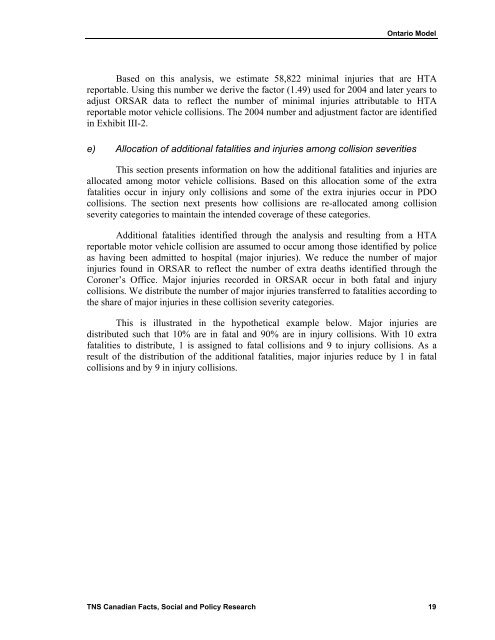Keith Vodden Dr. Douglas Smith - Transports Canada
Keith Vodden Dr. Douglas Smith - Transports Canada
Keith Vodden Dr. Douglas Smith - Transports Canada
You also want an ePaper? Increase the reach of your titles
YUMPU automatically turns print PDFs into web optimized ePapers that Google loves.
Ontario Model<br />
Based on this analysis, we estimate 58,822 minimal injuries that are HTA<br />
reportable. Using this number we derive the factor (1.49) used for 2004 and later years to<br />
adjust ORSAR data to reflect the number of minimal injuries attributable to HTA<br />
reportable motor vehicle collisions. The 2004 number and adjustment factor are identified<br />
in Exhibit III-2.<br />
e) Allocation of additional fatalities and injuries among collision severities<br />
This section presents information on how the additional fatalities and injuries are<br />
allocated among motor vehicle collisions. Based on this allocation some of the extra<br />
fatalities occur in injury only collisions and some of the extra injuries occur in PDO<br />
collisions. The section next presents how collisions are re-allocated among collision<br />
severity categories to maintain the intended coverage of these categories.<br />
Additional fatalities identified through the analysis and resulting from a HTA<br />
reportable motor vehicle collision are assumed to occur among those identified by police<br />
as having been admitted to hospital (major injuries). We reduce the number of major<br />
injuries found in ORSAR to reflect the number of extra deaths identified through the<br />
Coroner’s Office. Major injuries recorded in ORSAR occur in both fatal and injury<br />
collisions. We distribute the number of major injuries transferred to fatalities according to<br />
the share of major injuries in these collision severity categories.<br />
This is illustrated in the hypothetical example below. Major injuries are<br />
distributed such that 10% are in fatal and 90% are in injury collisions. With 10 extra<br />
fatalities to distribute, 1 is assigned to fatal collisions and 9 to injury collisions. As a<br />
result of the distribution of the additional fatalities, major injuries reduce by 1 in fatal<br />
collisions and by 9 in injury collisions.<br />
TNS Canadian Facts, Social and Policy Research 19
















